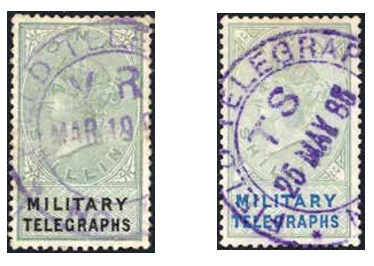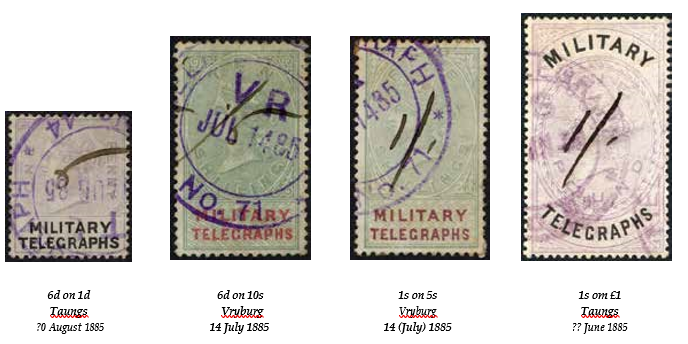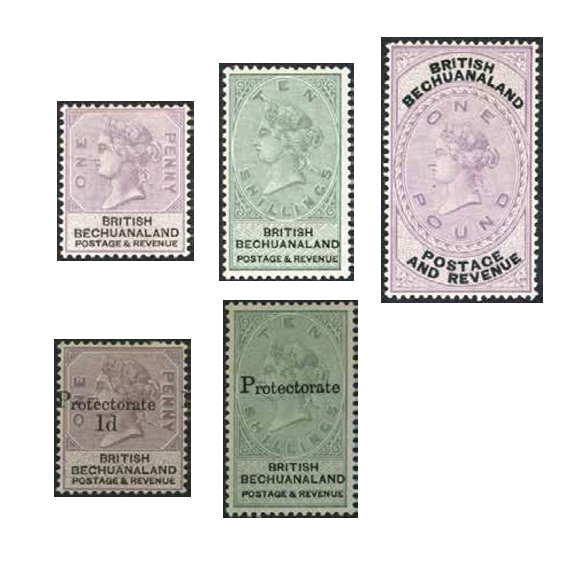THE UNAPPROPRIATED DIE ERA: 1884-1885







Figure 1 -Unappropriated Dies – Die Proofs, 1872
While proofs of 19 duties were prepared for use for varying Great Britain revenues, the eight duties shown above were those appropriated for the Military Telegraphs issue in 1884
“In essence De La Rue prepared a set of dies for each value desired that could be overprinted with the specific use needed utilising the same basic design”
A little explored area is the development of the Military Telegraph stamps from the Great Britain Unappropriated Dies and their application and use in 1884-1885 for the Bechuanaland Expedition. The Military Telegraph Unappropriated Die stamps were used in payment of fees for use of the military telegraph system where deployed in areas of military conflict within the British Empire between 1884 to 1886.
Further, the importance in the use of the Military Telegraph stamps for the Bechuanaland Expedition, led by Major General Sir Charles Warren, undoubtedly influenced the eventual use of De La Rue’s Unappropriated Dies for the first stamps of British Bechuanaland and Bechuanaland Protectorate in 1887 and 1888 respectively.
The Unappropriated Dies
The Unappropriated Die issue was developed by De La Rue in 1872 for the United Kingdom to provide a cost effective printing method by producing a uniform design for a multitude of different revenue uses. In essence De La Rue prepared a set of dies for each value desired that could be overprinted with the specific use needed utilising the same basic design. Subsequently 19 duties were prepared and ultimately over thirty different series of revenue stamps were produced utilising the Unappropriated Die printed for internal Great Britain use (see Figure 1).
The first use of the unappropriated die stamps external to the United Kingdom was in 1879 for the revenues of Cyprus. Then, the Military Telegraph stamps were first issued in September 1884 for use in Egypt followed by the December 1884 release for use by the Warren Expedition in Bechuanaland.
The Bechuanaland Expedition
The Bechuanaland Expedition, otherwise known as the Warren Expedition, was raised to:
- Provide British protection to the native chiefs from the Boers in Stellaland and Goshen, which ultimately resulted in those Boer republics becoming part of the new colony of British Bechuanaland (established 30th September 1885);
- Maintain British expansionary interests to the north; and
- Address concerns against potential encroachment of the Germans from German Southwest Africa.
Warren’s instructions provided by the Colonial Office on 17 November 1884 was “… to remove the filibusters [the Boers in Stellaland and Goshen] from Bechuanaland, to restore order in the territory, to reinstate the natives on their lands, to take such measures as may be necessary to prevent further depredation, and, finally, to hold the country until its further destination is known.”1
When formed in Cape Town in December 1884 to January 1885 the Warren Expedition comprised 8,000 troops. Dispatched mid- January the Expedition worked its way north and established a forward base at Barkley West. The Expedition achieved its primary objectives of removing the Boer filibusters without a shot being fired as well as securing treaties from varying tribes and reached Molopolole by mid- March. The Expedition was disbanded in August 1885. On September 30th British Bechuanaland became a Crown Colony. The area north of the Molopo River became the Bechuanaland Protectorate.
The Genesis of the Military Telegraphs Stamps
While the production and printings of the unappropriated die issues are relatively well understood for the internal revenue issues of the United Kingdom, there is less knowledge on the external applications to the countries where used, such as the Military Telegraph stamps, due to significantly less usage and overall surviving material. The paucity of philatelic literature specific to the Military Telegraph issues supports this premise.2 But the few sources that exist are extremely important to the study and overall contribution of knowledge on their production and use, in particular Creeke in 18913, and over 110 years later, Langmead in 20034. Additional sources of interest include Stanford5 and Panting6. While not specific to military telegraphs, the military postal history of the Warren Expedition in Trotter7, Briscoe8, and Drysdall9 provide additional insights into the various postal and telegraph offices in which communications traversed during this time.
Per Telegraph regulations, the charge for sending a telegraph by non-military (non- official) messages was 10 piastres for five words or 1s 0½d within a region, the regions being established by Telegraph regulations for use in Egypt and Sudan10. Since there was no ½d unappropriated die the 1d Military Telegraph duty was often bisected. As Creeke notes in his 1891 treatise on Military Telegraph stamps, “the immediate cause of the issue of these stamps… was the inconvenience caused to the officials in charge of the Army Telegraphs in Egypt … to keep account of small amounts paid in [local] currency.”11 It is presumed that sometime in mid 1884 the Director of Army Telegraphs in Egypt, Colonel Webber, Royal Engineers, applied to the Controller of Stamps at Somerset House for the unappropriated die stamps to be appropriated for Military Telegraphs.
The request was quickly addressed by the Controller of Stamps and De La Rue but not without machinations. Since the stamps were regarded as experimental, the Board of Inland Revenue would not pay for the preparation of the plates for the overprint of “Military Telegraphs” on the unappropriated die stamps. Although the panes consisted of 120 pence, 84 shilling, and 60 pound stamps each De La Rue responded by producing one-third size plates for the overprint as an economy measure, and considerably raised their printing charges because of the number of ‘pulls’ required to apply the overprints.
Thus, De La Rue made the formes in sets of 40, 28, and 20 leads for pence, shilling, and pound duties respectively at exactly one third of a pane of the relevant unappropriated die stamps as can be seen from the piece extracted from the Striking Book in Figure 212.As discussed above, these were considered temporary confirmed by the fact that the Die proof for the three formats, pence, shilling, and pound, are endorsed in red manuscript “Temporary Chgd with stamps” and dated “Sept 5th”.

for the Temporary Plates Ex Langmead
The first consignment using the temporary plates was printed on the 11th September 1884 (see Figure 3). The stamps were printed on white wove gummed paper and the pence, shilling, and pound values were watermarked ‘orbs’, ‘vr’ sideways, and ‘two orbs’ sideways respectively. They were supplied to Colonel Webber for use in the abortive 1884 Nile Expedition intended to relieve Khartoum and were sent off to Egypt immediately following printing13.








Figure 3 – The Military Telegraphs Issued Stamp
Subsequently a further printing from these plates was made to meet the needs of the Warren Expedition in Bechuanaland. This consignment was forwarded on the 28th November 1884 to Captain Richard Jelf, the Director of Military Telegraphs, on board the Pembroke Castle which was set to sail from London to Cape Town. Table 1 summarises the quantities printed.

November 1884
Permanent full size plates of 120 leads for the pence plate, 84 leads for the shilling series, and 60 leads for the pound series were made 9 January 1885 for the pence plate and 15 January 1885 for the shilling and pound plates as shown on the De La Rue Striking Book pieces (Figure 4).

While no further supplies were made to Bechuanaland, all stamps overprinted from these new plates were immediately used for telegraphic purposes in Egypt and the Sudan.
Military Telegraph Usage in Bechuanaland
As the Warren Expedition moved north telegraphic lines were established (Figures 5 and 12). The official report on the Bechuanaland Field Force’s Telegraph operations was prepared by Captain Jelf covering operations from 20 December 1884 through 31 May 188514.The report summarises the activities of the Field Telegraph operations during the Expedition noting that 220 miles of field telegraph line from Barkley to Mafeking, later to extended to Molepolole, was set up with 14 telegraph offices (see map in Figure 6) sending 39,373 telegraph messages, 23,596 for official (military) purposes and 15,777 for private purposes including press messages.15 An excellent contemporary account of the operations of the telegraph is provided by H.H. Flowers, who toward the end of the Expedition was in charge of the Setlagoli office and later, in 1890, became the Postmaster of Mafeking.16


Figure 6 – Warren Expedition – Military Telegraph and Postal Route North From Cape Colony
Bechuanaland Field Force Distribution Sketch, 28.5.85, Postal, Telegraph, and Signal Stations
Source: Quartermaster General’s Diary No. 9, from 1st May to 31st May (1885), in Diary of the Bechuanaland Field Force, 1884-85 (War Office)
Double circle Field Telegraph cancellers were used with purple ink. The cancellers for Vryburg (VR) and Taungs (TS) have been recorded used on stamps (Figure 7) and those for Setlagoli (SH) and Mafeking (MF) on Military Telegraph telegrams (Army Book form 295C). There are very few known examples of the Military Telegraphs stamp or telegram from these four offices and no examples known for the other 10 offices.

Right: 2s cancelled at Taungs, 25 May 1885
Ex Langmead
Surcharges in Manuscript
Supplies of stamps of the most commonly used values, the sixpence and one shilling, quickly ran out and by mid-June it became the practice to surcharge some of the lesser used values in manuscript. Known to be surcharged between May and September 1885, examples are recorded of a 6d surcharge on the one penny and 10s stamps and a 1s surcharge on the 5s and £1 values (Figure 8).

Military Telegraph Forms
When received, incoming Military Telegraph Telegrams were transcribed on Army Book form 295C and provided to the recipient. Since the policy was to destroy telegraph forms from the sender, no more than six are known to have survived from the Bechuanaland Expedition.
All the telegraph forms that have survived relate to a local supplier of goods to the Expedition, McHattie, who was accused of fraudulent dealings in the procurement of forage for the military station at Mafeking but protested his innocence very forcibly. “He was arrested, claimed his innocence, and released. Methuen kept copies of the telegram[s] because McHattie threatened with a law suit.”17 Figure 9 includes two telegraph forms from the McHattie incident.


To Col. Methuen, Setlagoli from McHattie, July 16 85:
- Sir, on my arrival here as a prisoner was at once released as there had never been any charge made against me. I then wired you for copies of telegrams on which
- you arrested and forwarded me on here [Mafeking] which you evidently refuse to supply me with. I therefore now give you notice which I will give you later in writing that I hold you personally responsible for three thousand pound damages and will take such steps as I think necessary to recover the same before your leaving country
Figure 9 – Military Telegraphs Army Book 295 C. Forms – The McHattie Correspondence
Two Military Telegraphs of a two page delivery copy sent on the 16th July 1885 from Mafeking to Setlagoli. Cancelled with the double circle Field Telegraph receiver canceller for Setlagoli (SH). Ex Wesseley
Military Telegraph and the Unappropriated Die Stamps Post Bechuanaland Expedition Following the demobilization of the Bechuanaland Expedition in August 1885, the telegraph line (and mail transport) was turned over the Bechuanaland Border Police (BBP). Much of the line was temporary and was soon replaced with permanent iron poles versus the original wooden poles used and other materials were upgraded. Also, as the railway was expanded from Kimberly to Mafeking, the telegraph line was moved adjacent to the new rail line.
The Military Telegraph stamps continued use in Sudan and Egypt until replaced in July 1886 by locally produced overprints in Cairo, self- inked in local currency as authorized by Major Bagnold, Director of Army Telegraphs at that time. This was later replaced with a version of the overprint printed by De La Rue, known as the London Overprints. These were used through the Egyptian campaign’s conclusion in 1889. Future campaigns in the Gold Coast (Ashanti), South Africa and Natal during the Boer Wars, as well as Army Manoeuvres in the United Kingdom utilised the Unappropriated Die stamps appropriated with the wording “Army Telegraphs” in place of “Military Telegraphs” Figure 10).18

Selected Values Shown Above
Top Left: Cairo Overprints, self-inked
Top Right: London Overprints, printed by De La Rue Bottom: Army Telegraphs

Bechuanaland the Unappropriated Die stamps were the first issue of stamps specific to British Bechuanaland. Twelve values were released on 1 November 1887. The use of the Unappropriated Die stamps were also used for the first Bechuanaland Protectorate stamps with the 1887 series overprinted “Protectorate” (Figure 11).

Source: Illustrated London News, 28 March 1885
More on these issues will be presented in a future article. The David Spivack Collection of Queen Victoria Overprinted for use in the Bechuanalands will be offered for sale at RPSL London on 13th May 2025. For further information please contact Josh Barber, [email protected].
This article originally appeared in the Journal of the Rhodesian Study Circle, September 2023, Issue no. 298, pp. 341-347.
By David Spivack FRPSL
- British Parliamentary Papers, LV (1884-
85), C. 4227, Commission and Instructions to Major General Sir Charles Warren, KCMG, as Special Commissioner to Bechuanaland with a Memorandum by Sir
C. Warren, pp. 4-6. ↩︎ - The Military Telegraph issue was used in Egypt, Bechuanaland, and Sudan. The Army Telegraph issues were used in Gold Coast and also throughout South Africa during the Anglo-Boer War, including Natal. There was also use of the Army Telegraph stamps in the United Kingdom during Army Manoeuvres that took place between 1896-1899. ↩︎
- Creeke, A.B. “Military Telegraphs, a Paper Read Before the Philatelic Society, London, Feb. 20th, 1891.” The Philatelic Record, vol. XIII, no. 48, pp 83-88. ↩︎
- Langmead, Peter and Huggins, Alan. The Telegraph Stamps and Stationery of Great Britain 1851-1954 (Great Britain Philatelic Society, London, 2003), pp. 76-110. ↩︎
- Stanford, Tony. “The Use of Military and Army Telegraphs Stamps in British
Military Campaigns, 1884-1902.” Gibbons Stamp Monthly, vol. 41 no. 2, July 2010,
pp. 53-57. ↩︎ - Panting, Steven. “Military and Army Telegraphs.” http://www.telstamps.org.uk, https://telstamps.org.uk/Telegraphs/Army-
1.html. Accessed 26 June 2023. ↩︎ - Trotter, Brian. “The Warren Expedition.” The London Philatelist, vol. 129, whole no. 1474, April 2020, pp. 109-113. ↩︎
- Briscoe, Andrew. “The Early History of Postal Services in the Bechuanaland Protectorate to 1888.” The London Philatelist, vol 131, whole no. 1498,
September 2022, pp. 374-376. Also see Briscoe, Andrew. “The Bechuanaland Expeditionary Field Force.” The South Africa Philatelist, vol 99, no.2, whole no. 977, April 2023, pp. 50-52. ↩︎ - Drysdall, Alan R. “A Postal History of Stellaland.” The London Philatelist, vol. 101, whole no. 1191, April 1992, pp 97-
98. ↩︎ - Langmead, Peter and Huggins, Alan. Op. cit., p. 80. ↩︎
- Creeke, A.B. Op. Cit., pp 83-88. ↩︎
- Langmead, Peter and Huggins, Alan. Op. cit., p. 81, referring to the 11 September 1884 De La Rue Inland Revenue Private Day Book records. ↩︎
- Examples of use of the Military Telegraphs stamps in the 1884 Nile Expedition are unknown but there are three known examples of use in Egypt dated 1886: 1)
a presentation sheet of all values tied by ‘ARMY TELEGRAPH / CAIRO’ circular date stamp (cds) and dated ‘9 MAI 86’ which includes the only know 1d bisected for use as ½d; 2) a 10s Military Telegraph stamp with a March 1886 CAIRO cds; and a 1d used in Mar 25 but no location is noted. ↩︎ - Jelf, Richard F., Captain, R.E. Report of proceedings of Bechuanaland Field Force 1884-1885. War Office, 26 June 1885, pp.
102-109. ↩︎ - Ibid. p. 108 ↩︎
- Flowers, H.H. “Bechuanaland Telegraphs.” St. Martin’s Le-Grand, vol. VI, 1896, pp. 320-328. ↩︎
- Thy, Peter. “Early Bechuanaland Telegraph Forms.” Exhibit, p.3, found in https://stampssa.africa/wp-content/ uploads/2021/07/Early-Bechuanaland-
Telegraph-Forms-optimize.pdf. Accessed 26
June 2023. ↩︎ - In addition to the Unappropriated Dies overprinted “Army Telegraphs,” the Queen Victoria ½d Jubilee was overprinted “Army Telegraphs”. ↩︎
